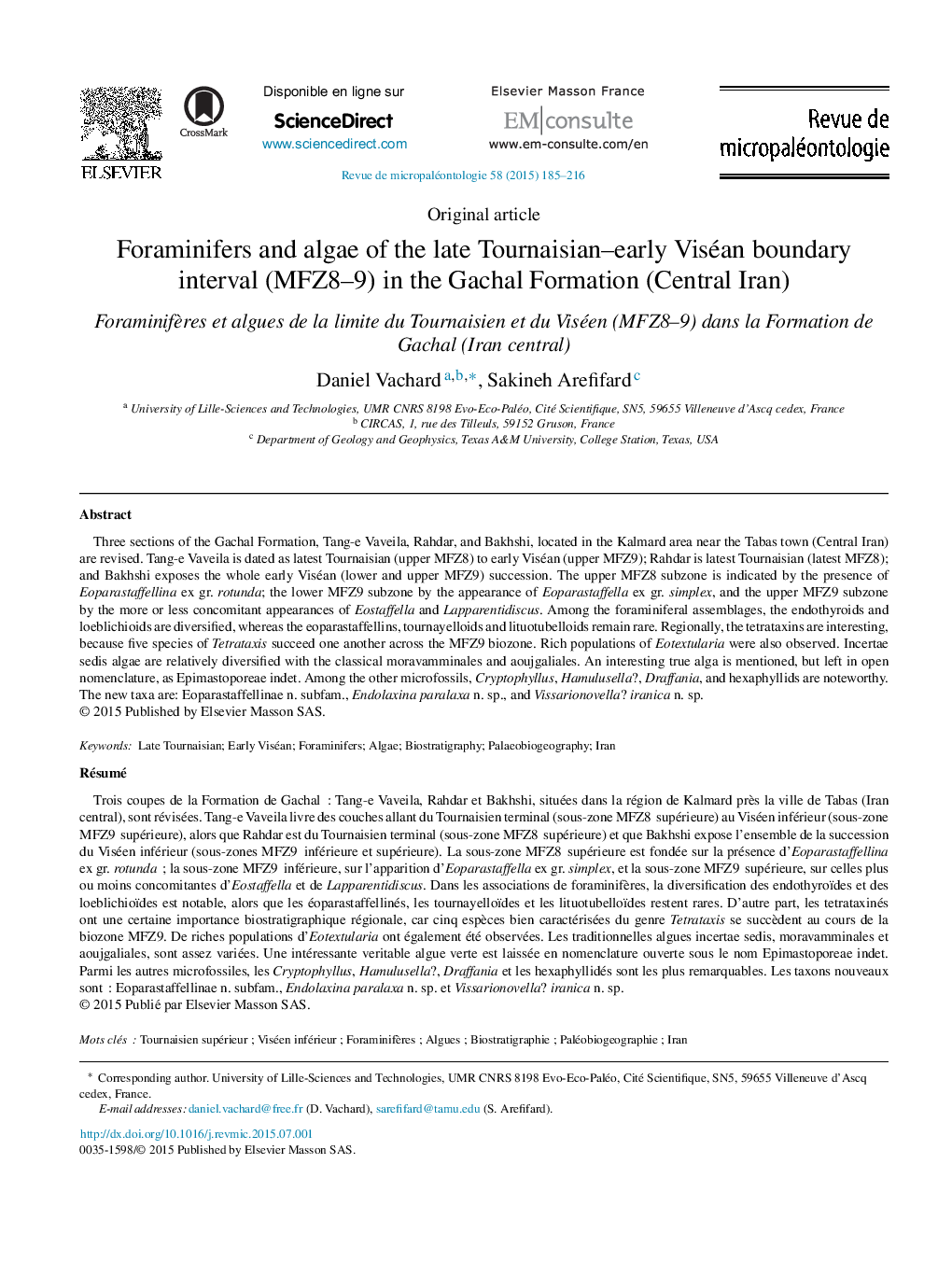| کد مقاله | کد نشریه | سال انتشار | مقاله انگلیسی | نسخه تمام متن |
|---|---|---|---|---|
| 4751393 | 1361053 | 2015 | 32 صفحه PDF | دانلود رایگان |

Three sections of the Gachal Formation, Tang-e Vaveila, Rahdar, and Bakhshi, located in the Kalmard area near the Tabas town (Central Iran) are revised. Tang-e Vaveila is dated as latest Tournaisian (upper MFZ8) to early Viséan (upper MFZ9); Rahdar is latest Tournaisian (latest MFZ8); and Bakhshi exposes the whole early Viséan (lower and upper MFZ9) succession. The upper MFZ8 subzone is indicated by the presence of Eoparastaffellina ex gr. rotunda; the lower MFZ9 subzone by the appearance of Eoparastaffella ex gr. simplex, and the upper MFZ9 subzone by the more or less concomitant appearances of Eostaffella and Lapparentidiscus. Among the foraminiferal assemblages, the endothyroids and loeblichioids are diversified, whereas the eoparastaffellins, tournayelloids and lituotubelloids remain rare. Regionally, the tetrataxins are interesting, because five species of Tetrataxis succeed one another across the MFZ9 biozone. Rich populations of Eotextularia were also observed. Incertae sedis algae are relatively diversified with the classical moravamminales and aoujgaliales. An interesting true alga is mentioned, but left in open nomenclature, as Epimastoporeae indet. Among the other microfossils, Cryptophyllus, Hamulusella?, Draffania, and hexaphyllids are noteworthy. The new taxa are: Eoparastaffellinae n. subfam., Endolaxina paralaxa n. sp., and Vissarionovella? iranica n. sp.
RésuméTrois coupes de la Formation de Gachal : Tang-e Vaveila, Rahdar et Bakhshi, situées dans la région de Kalmard près la ville de Tabas (Iran central), sont révisées. Tang-e Vaveila livre des couches allant du Tournaisien terminal (sous-zone MFZ8 supérieure) au Viséen inférieur (sous-zone MFZ9 supérieure), alors que Rahdar est du Tournaisien terminal (sous-zone MFZ8 supérieure) et que Bakhshi expose l’ensemble de la succession du Viséen inférieur (sous-zones MFZ9 inférieure et supérieure). La sous-zone MFZ8 supérieure est fondée sur la présence d’Eoparastaffellina ex gr. rotunda ; la sous-zone MFZ9 inférieure, sur l’apparition d’Eoparastaffella ex gr. simplex, et la sous-zone MFZ9 supérieure, sur celles plus ou moins concomitantes d’Eostaffella et de Lapparentidiscus. Dans les associations de foraminifères, la diversification des endothyroïdes et des loeblichioïdes est notable, alors que les éoparastaffellinés, les tournayelloïdes et les lituotubelloïdes restent rares. D’autre part, les tetrataxinés ont une certaine importance biostratigraphique régionale, car cinq espèces bien caractérisées du genre Tetrataxis se succèdent au cours de la biozone MFZ9. De riches populations d’Eotextularia ont également été observées. Les traditionnelles algues incertae sedis, moravamminales et aoujgaliales, sont assez variées. Une intéressante veritable algue verte est laissée en nomenclature ouverte sous le nom Epimastoporeae indet. Parmi les autres microfossiles, les Cryptophyllus, Hamulusella?, Draffania et les hexaphyllidés sont les plus remarquables. Les taxons nouveaux sont : Eoparastaffellinae n. subfam., Endolaxina paralaxa n. sp. et Vissarionovella? iranica n. sp.
Journal: Revue de Micropaléontologie - Volume 58, Issue 3, July–September 2015, Pages 185–216